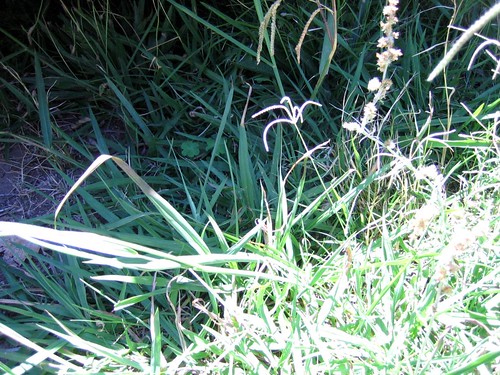
These are the socks I made for my sisters for Christmas. The story of how they finally came to be handed over is long and involved, so I'll understand if you skip it. But come back tomorrow for more pretty pictures.
It started some time before Christmas 2006 (yes, 2006) with Knitty's
Lolita legs. Or was it the Nina Chakkor's Anna socks from
Rowan 40? I know I thought about tracking down that book, after seeing those lacy knee highs on a couple of blogs, but I decided to have a go at making Lolita as a knee high.
After a few false starts the toe went ok, and the foot took no time at all on 3.25mm needles. The instructions for the short row heel were so easy, because you deliberately don't bother to wrap the stitches - the resulting holes contribute to the lacy look - and suddenly it was magical, my knitting had turned a corner and I was making a sock.
This is where I started the rocky journey of modifying the pattern. I wanted a knee high sock, and Lolita Legs is a lace-up-the-back, thigh high. So I kept knitting in the round from the ankle up, instead of starting to knit back-and-forth as the pattern required. So far so good. Easier than the pattern, really. Whee! The fishnet pattern has a plain section that runs up the back of the leg, where the lacing would go. I thought I might as well keep this, as a kind of seam effect running up the back of the leg, and I could try to hide the calf increases in it. On paper, this was a good plan. But it didn't work.
The Lolita pattern was for a medium to large leg, and I was knitting for my small-med sister, and using different wool anyway, so I just worked out where the calf increases should go by trying it on. As I tried it on I realised that the fishnet pattern naturally wants to sit on the bias, with the lines going diagonally up the leg. This meant that the 'seam' also spiralled bizarrely up the leg.

The way that it is modelled in the pattern picture, with the lines running straight up the leg, seemed to require some twisting of the sock as you put it on. This had the effect of taking out much of the stretch, and therefore the clinginess, of the stitch pattern. I realise now that the recommended yarn (Elann Esprit) has more stretch than the sock wool (Patonyle) I used, so that might have worked better.
Also, the increases were not in fact very well hidden, and they looked bad.
Of course I had knitted the full leg by the time that I decided it very obviously didn't work. I had even done the ribbing at the top, doubling the stitch count by knitting front and back into every stitch, and going down to 2mm needles, for a nice fine-gauge ribbing - which, as you may imagine, took quite a while.
On a few previous projects I had built up some confidence with the technique of dropping stitches down a few rows to fix mistakes. So I hit on a crazy scheme: I would drop the whole group of stitches for the plain section and increases, ALL the way down to the ankle, then knit them back up again in the fishnet stitch.
 Yes, I did this to my knitting.
Yes, I did this to my knitting.And the repair did work. It certainly wasn't fast but I would have gotten there in the end.

While I considering what to do with the first sock, I had cast on and knit the second sock according to the new plan - no wacky seam spiralling up the leg, thanks very much, just the fishnet pattern all the way around. At this stage I was still aiming for the pair to be finished for a Christmas present. And I still thought I might design and knit another pair of lacy knee highs for my other sister, although time was getting a bit short.
I was working with Aero metal double pointed needles, the only kind I had at that stage, and my tension was very uneven. I had gotten a bit better with the second stock, not fabulous, but the first really was pretty bad.
See in the photo below, how the diagonal lines are close together and then further apart? No, that didn't go away with blocking.

And perhaps inevitably, in the slow process of fixing the 'design misstep' in the first sock, the reknit portion was coming out a bit uneven with the rest of the sock.
It must have been around this point I put down the blue pair and tried to redeem myself, with just a week or so to go till Christmas. I chose a stitch pattern,
English mesh lace, from one of my books (The Hamlyn Complete Guide to Knitting by Eleanor Van Zandt) and made a start with the green Heirloom Argyle, for my other sister. When I finished the heel and tried it on, I was sure that it was going to be too tight for her. Damn. I faced starting again with more stitches.
And that was when I gave up on the whole lacy christmas stockings thing and raced out to do some last minute present shopping. Both sisters have their birthdays in February, so I thought I could take a break and reassess.
A couple of months later, I bought a large set of bamboo double pointed needles on ebay. I was pretty sure that the weight of the metal needles had been a big contributer to my tension problem. So I took out that first blue stocking - a large portion of it still looking like a messy pile of blue spaghetti because I was nowhere near finished on the repair operation - and unravelled it right down to the heel. Then I put the stitches back on my new bamboo needles and knit it all again.
I was right, the lighter, stickier needles helped a lot. I still wasn't feeling totally thrilled with the fishnet pattern. I was a bit over the project by this stage. I couldn't decide whether to reknit the second sock on bamboos, accept it as is, or throw the whole thing in the darkest corner of the room. Option c kind of happened by default. I put it all away in a bag, the embryonic green lace sock too. Over the next several months they occasionally popped into my head and bothered me, but I didn't do anything about it. I needed time.































